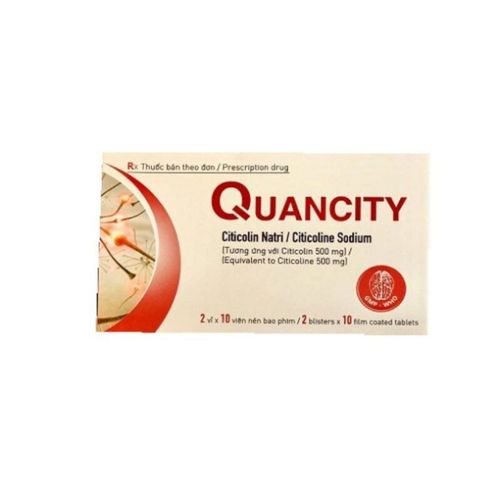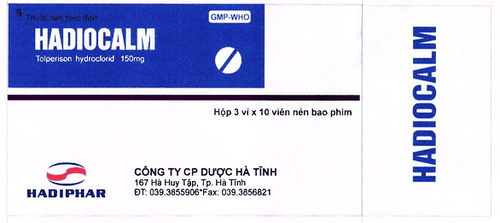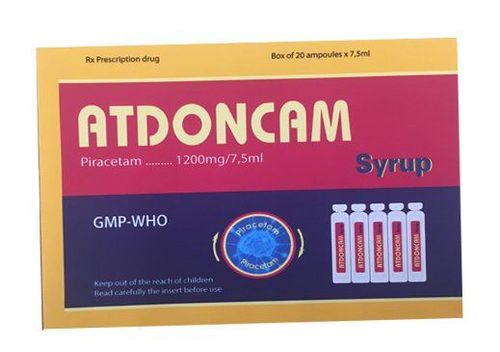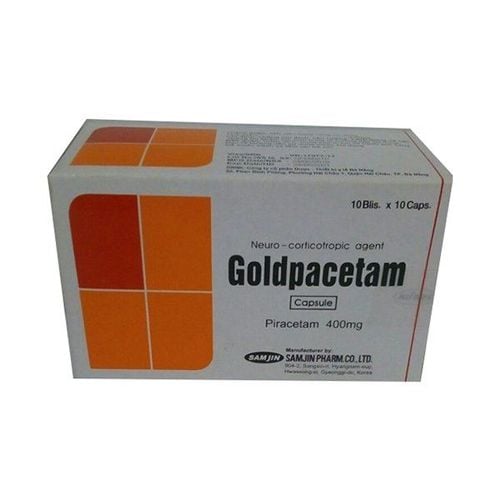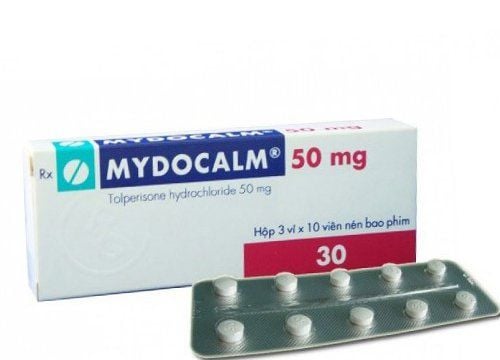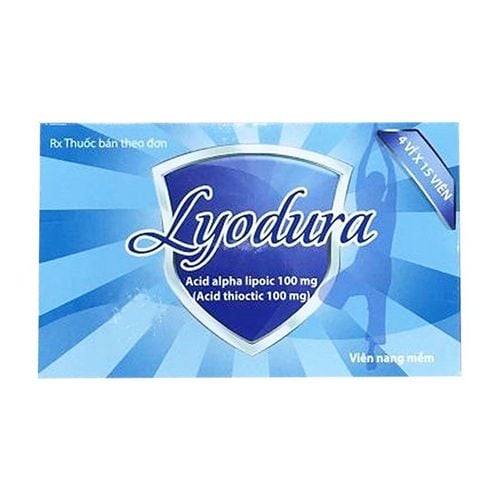This is an automatically translated article.
Topernak is prescribed for the treatment of spasticity after stroke in adults. In addition, Topernak is also used to treat atherosclerosis, diabetic vascular disease, thromboembolic vasculitis, Raynaud's disease, scleroderma. To ensure effective use, users need to follow the instructions of their doctors, and refer to more information about the uses of Topernak in the following article.
1. What are the uses of Topernak?
1.1. What is Topernak? Topernak belongs to the group of drugs that relax muscles and increase muscle tone. Topernak medicine has the main ingredient Tolperison HCl 150mg. Topernak is manufactured at Dong Nai Pharmaceutical Joint Stock Company - VIETNAM and registered by Dong Nai Pharmaceutical Joint Stock Company.
The drug is prepared in the form of film-coated tablets, and packaged in boxes of 3 blisters x 10 tablets, boxes of 10 blisters x 10 tablets
1.2. What is Topernak used for? Indications for use of Topernak drug:
Topernak drug is used to treat skeletal muscle hypertonia, pathologies in organic neurological disorders such as multiple sclerosis, pyramidal tract lesions, spinal cord disease, cerebrovascular accident, or encephalomyelitis.... Muscle spasms, hypertonia, and spasms associated with movement diseases (eg, spondyloarthritis, lumbar and cervical syndromes, spinal rheumatism and arthrosis of the vertebral column). large joints). Rehabilitation of functions after trauma and orthopedic surgery. It is also used to treat thrombotic diseases (thrombotic vasculitis, obstructive atherosclerosis, Raynaud's disease, diabetic vascular disease, and diffuse scleroderma) such as those occurring on an impaired basis. neurologic and vascular distribution (neurodystrophy or cyanosis of the extremities and intermittent pulse). Little's disease (a rare disease in children, presenting with stiff and crossed legs, mental retardation, possibly with seizures, chorea, choreographia due to cerebral sclerosis) and other encephalopathies by dystonia. Contraindications to the use of Topernak:
When the patient is too sensitive to any of the ingredients of the drug. Mechanical weakness. Because of the lack of adequate study results, tolperisone hydrochloride injection is contraindicated in children. Relative contraindications: Pregnant women, especially in the first 3 months of pregnancy. Absolutely should not use Tolperisone hydrochloride while breastfeeding.
2. How to use Topernak
2.1. How to use Topernak Topernak drug is used orally, the daily dose is 150-450mg, divided into 3 equal parts depending on the needs and tolerance of each patient.
2.2. Dosage of Topernak: Adults: For oral administration, the daily dose is 150 to 450 mg, divided into 3 equal parts depending on the needs and tolerance of each patient. If administered by parenteral route, Tolperisone hydrochloride is administered intramuscularly at a dose of 100 mg twice daily or as a single dose of 100 mg per day, if intravenous injection is slow. Children: This injection is not intended for use in children. If the film-coated tablets are used, children under 6 years of age can be taken at a dose of 5 mg/kg body weight per day, these doses will be divided into 3 equal parts. In the group of children from 6 to 14 years old, the daily dose is from 2 to 4 mg/kg body weight, these doses are divided into 3 equal parts. Treatment for missed doses:
Usually all medicines can be taken within 1 to 2 hours of what is prescribed in the prescription. Unless there are stricter regulations on how long a drug should be taken, it can be taken a few hours after forgetting. However, if the time is too far from the time when you need to drink, you should not take it anymore, otherwise it may be dangerous to the body. It is necessary to follow the correct use or consult a doctor before taking the drug. Treatment of overdose:
Cases of Tolperison overdose are very rare. Tolperison has wide therapeutic boundaries. The highest daily dose recorded in the literature was up to 600mg without ever causing any serious toxicity symptoms. Some irritation has been observed after treatment in children at oral doses of 300 to 600 mg/day. In acute preclinical toxicity studies, high doses such as Tolperison may cause tonic-clonic convulsions, ataxia, respiratory paralysis or dyspnoea. Tolperison has no specific antidote. In case of overdose, treatment should be symptomatic and supportive.
3. Notes when using Topernak
When using Topernak, caution should be exercised in patients with hepatic and renal impairment or with the following allergic and hypersensitivity reactions:
After the drug was placed on the market, adverse reactions were reported. The most commonly reported tolperison drug is hypersensitivity reactions, ranging from mild cutaneous reactions to severe systemic reactions such as anaphylaxis. Possible manifestations include redness, rash, pruritus, urticaria, angioedema, tachycardia, dyspnea, and hypotension. The risk of hypersensitivity reactions is usually higher in women; Patients with a history of allergy or hypersensitivity to other drugs should be extra cautious when using Tolperison. Patients should be warned about the possibility of hypersensitivity reactions when using Tolperison. In case of any signs of hypersensitivity, the drug must be stopped immediately and consulted with a doctor. Tolperison should not be reused in patients with a history of hypersensitivity. Pregnancy:
In animal studies, Tolperison was not teratogenic. In humans, due to the lack of appropriate clinical data, tolperisone should not be used during pregnancy (especially during the first trimester) unless the benefit to the mother outweighs risks to the fetus. Lactation:
It is not known whether tolperison is excreted in breast milk, so tolperison should not be used during lactation. Because the drug can cause symptoms such as: dizziness, lightheadedness, so caution should be exercised while driving and while operating machinery. If you experience dizziness, lightheadedness, loss of concentration, or seizures, blurred vision, or muscle weakness when taking tolperison, you should consult your doctor.
4. Topernak side effects
Topernak causes myasthenia gravis, hypotension, headache, nausea, vomiting and abdominal pain. These side effects usually go away as the user reduces the dose. Rarely, hypersensitivity reactions such as pruritus, urticaria, erythema, anaphylaxis, angioedema or dyspnoea may occur.
5. Topernak drug interactions
Topernak interacts with other drugs:
Tolperisone hydrochloride strongly enhances the effect of niflumic acid, so if used concomitantly, the dose of niflumic acid should be reduced. Topernak drugs interact with drinks and foods:
When using Topernak in combination with tobacco, alcohol, beer or foods... may cause antagonism or synergism. You should read the instructions for use of the drug carefully or consult your doctor or pharmacist about taking Topernak with food, alcohol and tobacco.
6. How to store Topernak
Users need to carefully read the instructions and storage information of the drug listed on the packaging and instructions for using Topernak. Before using the medicine, check the expiry date. When the drug is no longer in use, it should be collected and disposed of according to the instructions of the manufacturer or the person in charge of medicine. Conventional drugs are stored at room temperature, avoiding direct exposure to sunlight or high temperatures because they can metabolize the ingredients in the drug. Above is all information about Topernak drug, patients need to carefully read the instructions for use, consult a doctor / pharmacist before using. Note, Topernak is a prescription drug, patients need to use the drug as prescribed by the doctor, absolutely do not self-treat at home.




